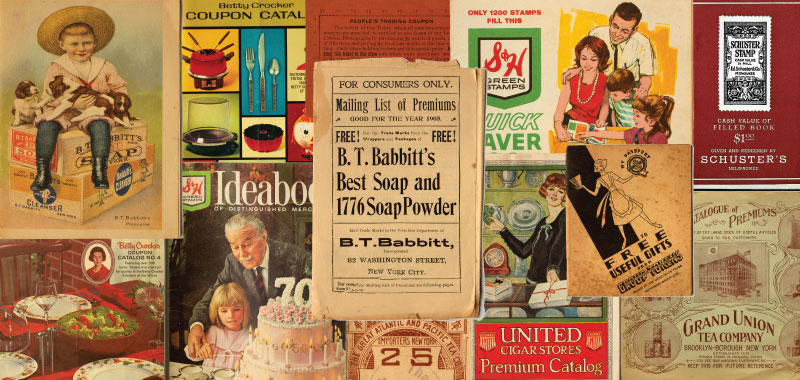
___
Loyalty programs have been around for hundreds of years, with approaches becoming more sophisticated over time. This article an in-depth look into the history of loyalty programs, covering the most significant phases of loyalty program evolution.
- Beer and Bread Tokens (Ancient Egypt)
- Copper Tokens (c. 1700 – 1800s)
- Trade Marks (1850s)
- Checks (c. 1860s)
- Tickets (1872)
- Certificates and Coupons (1890)
- Stamps (1891)
- Betty Crocker Coupons (1921)
- Miles & Points (1980s)
- Cryptocurrencies and Tokenised Assets (Today)
Beer and Bread Tokens (Ancient Egypt)
In Ancient Egypt: Anatomy of A Civilisation[1] Professor Barry Kemp argues that ancient Egyptians practised a type of reward program similar to modern frequent flyer programs, including status tiers and the ability to redeem on a wider variety of rewards.
For much of the pharaoh’s thousands of years of rule, they did not have money. It simply was not invented yet. Instead citizens, conscripted workers and slaves alike were all awarded commodity ‘tokens’ (similar to loyalty points or miles) for their work and temple time. The most common were beer and bread tokens. The tokens were physical things, made from wood, then plastered over and painted and shaped like a jug of beer or a loaf of bread.
The more senior people in the hierarchy were rewarded with the same tokens but received bonuses. The Rhind Mathematical Papyrus details examples and mathematical equations regarding how higher positions, such as the skipper, crew leader and doorkeeper, received double bread tokens compared to the rest of the crew. This could be construed as a variant of the status tier bonus, where higher tier members earn bonus points for transactions to reward them for their loyalty.
The tokens could also be exchanged for things other than bread and beer. Those high up enough to earn surplus tokens could redeem them on other goods and services, in the same way that frequent flyer members with lots of points can redeem them on flights and on non-flight rewards such as iPads, KitchenAid mixers and Gucci handbags.
While some of the characteristics are quite similar to a modern loyalty program, is this really a loyalty program? Some might argue it is simply a societal exchange system developed in the absence of fiat currency. Others might contend that is exactly what a modern loyalty program design is; a non-fiat exchange system utilising tokenised currencies.
Copper Tokens (c. 1700 – 1800s)
The first modern loyalty program, according to a New York Times article by Nagle (1973),[2] commenced in 1793, when a Sudbury, New Hampshire merchant began rewarding customers with ‘copper tokens’. The tokens could be accumulated and used for future purchases, thereby generating repeat visits, the core behavioural objective of loyalty program design. The idea was quickly replicated by other retailers and carried into the 18th century.
Is there evidence to support this claim? While copper loyalty tokens from Sudbury dating back to 1793 could not be found, the authors did identify other merchant-branded copper, brass and aluminium tokens created in the US in the 1800s. For example, the New York Times article by Nagle refers to a brass token created by Robinson & Ballou Grocers, dated 1863, which can be found online for sale by various coin dealers worldwide for as little as US$50.
This would appear to provide support for the existence of merchant loyalty tokens, however further investigation reveals these coins to be more accurately referred to as ‘Civil War’ tokens, which may not be related to loyalty programs at all.
During the 1861-64 US Civil War, high inflation sparked a frenzy of hoarding, with the focus on gold, silver and copper coins. With few coins left in circulation, merchants began to suffer as small denomination coins were the most commonly tendered at that point in time. To alleviate the situation, merchants began minting their own tokens to fill the void.[3] These were typically one cent in value and made of copper or brass, and were similar in size to government issued coinage.
This was not the first time such an approach has been taken by merchants. Between 1832-1844, ‘Hard Times’ tokens were created when the United States went through an economic depression over the fate of the Second Bank of the United States and the powers of the Federal Treasury. The climax of that period was the ‘Panic of 1837’, brought on by President Andrew Jackson’s requirement that banks and receivers of public money only accept gold or silver in payment for public lands as a way to reduce speculation. As a result, gold and silver were hoarded and loans were called in, generating a run on the banks. An insight from an article by the American Numismatic Association (Mudd, 2015) [4] states, ‘The immediate reason for the issuance of the tokens was the ongoing shortage of small change in the United States – a situation that had existed ever since the Colonial period despite the best efforts of the United States Mint’.
This provides an important clue for the investigation of the famed Sudbury merchant from 1793. It appears that coinage shortages also existed at that time right across the US.. A Quarterly Journal of Economics article (Barnard, 1917)[5] references merchants minting their own coins of brass and tin as early as 1701 after the Massachusetts mint was closed in 1697. Further examples are cited from Virginia as early as 1714, with many more coins created between 1773-74. In Connecticut, copper mine owner John Higley created the first recorded copper tokens between 1737-39, while Chalmers, a goldsmith of Annapolis, Maryland issued tokens in at least three denominations (shillings, sixpence, and threepence) just after the American Revolution in 1783. Barnard states that so many other merchants created silver and copper coins that laws were passed by Pennsylvania, Connecticut and New Jersey prohibiting the circulation of coins not expressly authorised.
Thus, the historical record appears to show the primary driving force for the creation by merchants of branded copper (and other metal) tokens was to address a severe shortage of coinage which was inhibiting commerce.
Did a Sudbury, New Hampshire merchant invent the world’s first loyalty program when they began rewarding customers with copper tokens in 1793? It is possible that such a merchant created branded copper tokens, however there is no evidence to support the claim made in the New York Times article (and repeated extensively across numerous books and websites) that they created the tokens in order to reward loyal customers. In fact, the likelihood is they were created to address a local coin shortage, and this was later misinterpreted as an early form of loyalty program currency.
Irrespective, the Coinage Act of 1864 enacted by Congress made the minting and usage of non-government issued coins illegal, ending this era forever.
Trade Marks (1850s)
Based on the available evidence, the true godfather of the modern loyalty program would appear to be B.T. Babbitt. Born in 1809, Benjamin Talbot Babbitt found his fortune in New York City in his early 30s by designing an original and cheaper process to make saleratus, a key base ingredient of baking powder. He soon expanded his product range to include yeast, baking powder and soap powder. He became the first to sell individually wrapped bars of soap, with ‘Babbitt’s Best Soap’ becoming a household name across the US.[6]
To boost repeat sales, in the 1850s[7] B.T. Babbitt, Inc. launched a new (and truly revolutionary) promotional program, where they invited customers to cut-out and collect the ‘trade marks’ from product packaging of Best Soap and 1776 Soap Powder. The trade marks could initially be redeemed for coloured lithographs by mailing them to the company. Soon after, the rewards range was expanded into a more comprehensive offering, which was promoted in the company’s ‘Mailing List of Premiums’.
As an example of the rewards on offer, The 1905 Mailing List of Premiums offers a wide range of choices, including a harmonica, felt pencil case or box of school crayons for 25 trade marks; a buckhorn handle pocket knife (2 blades), sterling silver thimble or pair of Uncle Sam suspenders for 50 trade marks; all the way up to a lady’s locket chain (14k gold filled), lady’s gold ring (12 pearls) or lady’s handbag for 225 trade marks.[8] These are not just practical, utilitarian products, but truly aspirational items which would have captivated the member base in a way which history has never seen before.
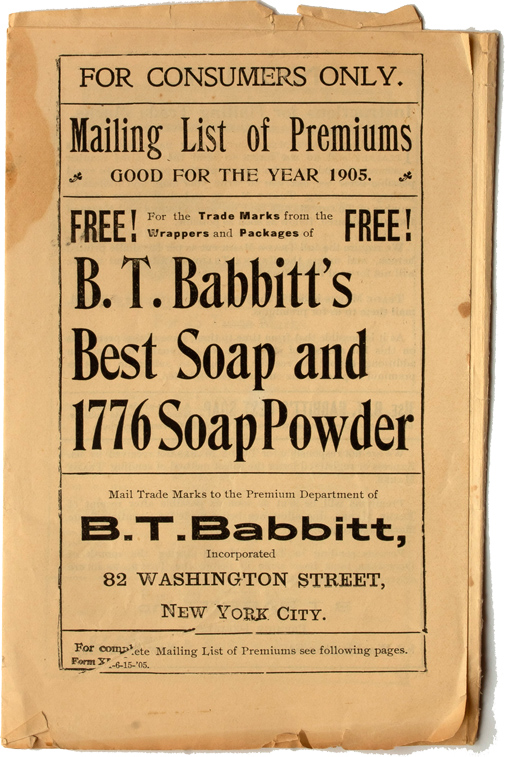
B.T. Babbitt also introduced the option for customers to visit their premium stores located in major cities across the US, as well as Canada, Porto Rico and Scotland, to redeem trade marks for ‘a large number of household articles, dolls, toys, etc.’.
As a new approach to marketing, the company positioned the program as a profit-sharing plan, potentially taking inspiration from dividends paid on shares or rebates paid on volume sales. The 1912 B.T. Babbitt’s Profit Sharing List[9] states ‘B.T. Babbitt was the originator of premiums… the firm has continued since that time to give its customers in the form of premiums a very material share of the profits of its immense business.’.
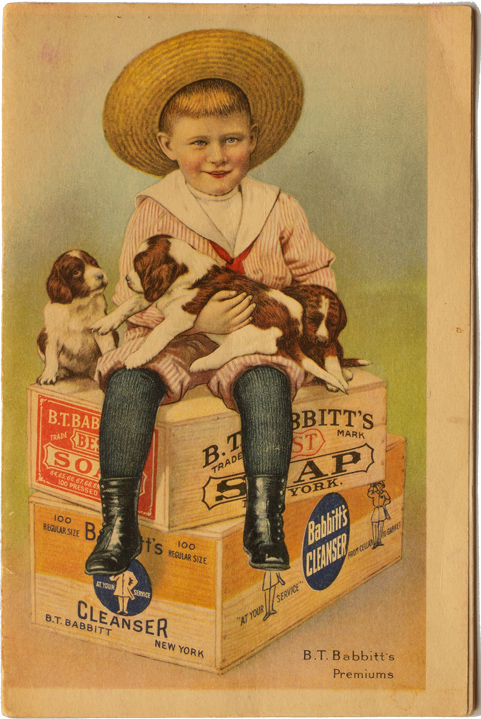
The Profit Share Plan also cautions, ‘When you buy all B.T. Babbitt’s Products, consisting of Soaps, Cleanser, “1776” Soap Powder, and Pure Lye or Potash, you are entitled to a return in the form of a premium. If you do not save the trade marks from any of the Babbitt articles you are losing just so much. These trade marks are worth fully one-half cent each to you if redeemed from our premiums.’
Checks (c. 1860s)
In the 1860s, the Great Atlantic & Pacific Tea Co. (which was set to become the largest retailer in the world under the A&P brand between 1920 into the 1960s[10]) launched a comparable program to reward their customers for purchasing a selection of their products. When transacting, customers would receive a red coupon known as a ‘check’, detailing the amount it was worth and the terms. One 1890 example states, ‘This Check (good for the amount as engraved for presents of Glass ware, China, etc.) is redeemable at any of our 200 Stores. Provided it is Stamped with the Address of the Store that issued it. Managers will be particular and allow no Checks to be given out before they are stamped. This Check is of no value except Stamped as per the foregoing. ALL CHECKS MUST BE PUNCHED AFTER REDEMPTION. PUNCHED CHECKS ARE OF NO VALUE.’[11]
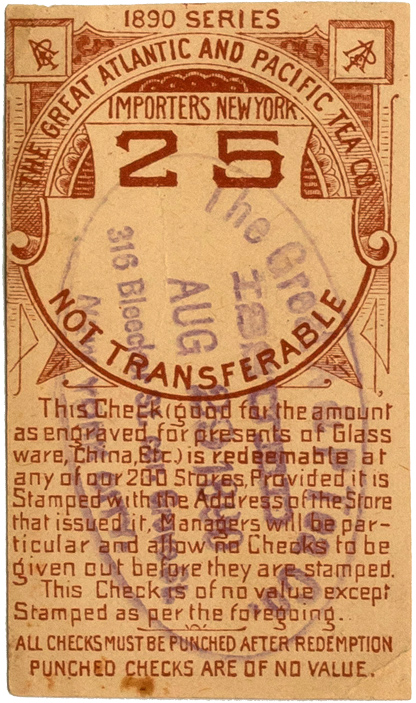
Checks could be accumulated and redeemed in stores for a range of consumer goods. This was incredibly popular with customers and it provided a strategic competitive advantage over smaller merchants who could not afford, and did not have the space, to provide such a sizeable rewards range. It also posed some challenges. According to Levinson,[12] ‘the premiums not only were costly, but also took up shelf space that could have displayed merchandise for sale. Many stores of the period looked more like gift shops than groceries’.
To address this issue, in the early 1900s the company published The Great Atlantic & Pacific Tea Co. Catalogue. This promoted a range of day-to-day homeware products including saucepans, teapots, knives, ironing boards, sugar tins, wash bowls, spoons, bread trays and more.[13] Once enough checks had been saved, members could send them to a central office and receive the reward by return freight,[14] reducing the need for each store to range the full rewards range.
A few years later, The Great Atlantic & Pacific Tea Co transferred their loyalty program operations to Sperry & Hutchinson, a stamp program covered later in this chapter.
Tickets (1872)
The Grand Union Tea Company was formed in 1872 in Pennsylvania and followed the lead of the Great Atlantic & Pacific Tea Co with their loyalty program design. The owners chose to sidestep retailers and sell their product directly to consumers, starting with door to door sales. They rewarded customers with ‘tickets’ which could be collected and redeemed for a wide selection of products from the company’s Catalog of Premiums.[15] The 1903 version of the Catalog of Premiums lists the full product range and prices (coffee, tea, spices, extracts, baking powder soap and sundries), as well as 17 pages of rewards. These include an Oak Roman Chair (100 tickets), lace curtains (120 tickets a pair), Ormolu clock (300 tickets) and dinner set Berlin 1903 (440 tickets). Customers could earn one ticket by buying a pound of coffee at 20 cents, two tickets for premium tea at 40 cents and one ticket for a packet of cloves at 10 cents. The catalogue proudly proclaims, ‘We advertise by giving presents with our goods, thus SHARING WITH OUR CUSTOMERS the profits of our business. Remember, you pay less for our goods of same quality than at other stores, and get presents in addition.’
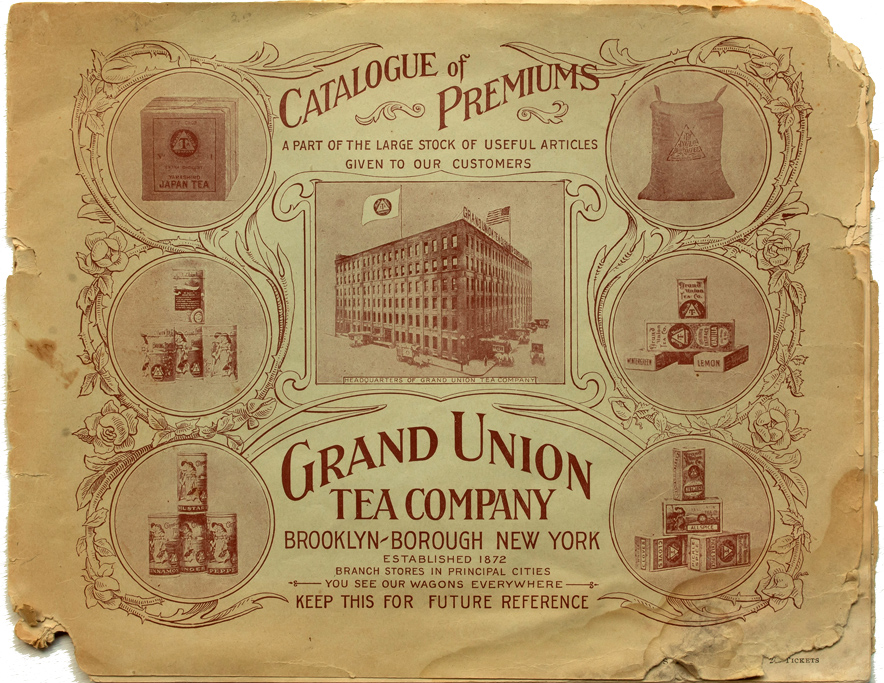
The 1971 New York Times article by Nagle included an interview with William H. Preis, senior vice president of the Grand Union Tea Company. Preis joined the company in 1933. By the time of the interview, the company had transitioned their tickets program to a coalition-based stamps program run by Stop & Save Trading Corporation. Customers could earn Triple-S Blue Stamps which cost the company 1 ¼ per cent of sales. Preis indicated they had been providing the stamps program for 16 years.[16]
Certificates and Coupons (1890)
This period may have potentially been a boom time for the newly designed loyalty marketing, with companies big and small adopting the approach. One example from 1890 is a ‘People’s Trading Coupon’ from Hunsicker & Warmkessell Photographers, based in Allentown, Philadelphia. The coupon is a sophisticated punch card which, when completed, provides the member with ‘one dozen of our best $4 Cabinet Photographs’. The member is reminded to ‘Tell your friends to get a ticket.’[17]
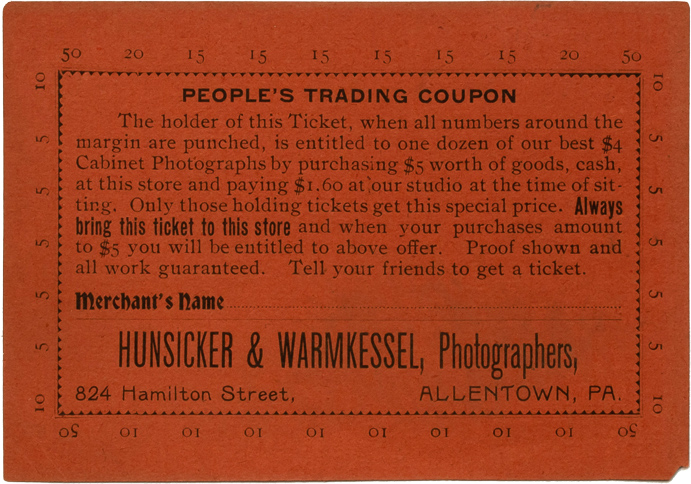
Another example is The United Cigars Store Co., founded in 1901 and sporting over 3,000 retail outlets at its peak in 1926.[18] They ran a successful ‘certificates and coupons’ rewards program (where five coupons were equal to one certificate). United built a coalition of partners by making deals with companies including Wrigleys, Swifts, Danish Pride, National, Barkers, Votan and Tootsie, all of which put United coupons within their product packaging. Certificates and coupons were redeemable by mail or at 250 redemption centres around the country. Rewards included a men’s gold-filled watch or six place settings of Rogers silver plate flatware (900 coupons), room-size oriental style rug (4,000 coupons), a Remington automatic shotgun (5,000 coupons and a four-wheel Studebaker carriage (25,000 coupons).
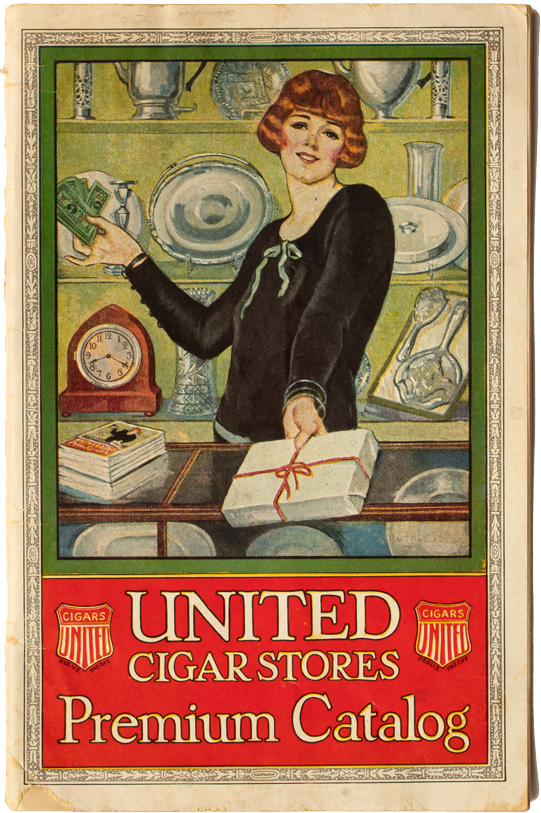
The United Cigars Store Co 1924 Premium Catalog[19] features a selection of well over one thousand reward items, including clothing, umbrellas, smoking accessories, razors, cutlery, leather goods, toiletries, jewellery, clocks, watches, kitchenware, headphones, cameras, sporting goods, toys, games and silverware.
Stamps (1891)
In the 1890s, companies began using physical ‘stamps’ to reward loyal customers. Customers could earn stamps when making purchases and were encouraged to stick them into collecting books. The books could then be exchanged for a wide range of rewards.
The first company to introduce stamps was Schuster’s Department Store in Milwaukee in 1891. Customers earned one stamp for every US10c spent. A filled book of 500 stamps was worth US$1 to redeem on rewards (a 2 per cent return on spend). By WWII, it appears the program had expanded into a small coalition, with a stamp book dating from that era promoting ‘Valuable Schuster Stamps Are Now Also Given By Many Food Markets.’[20]
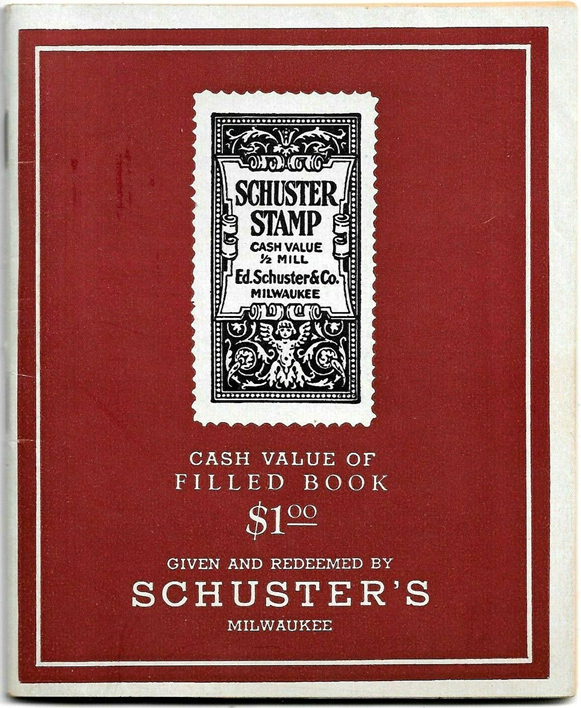
In 1896, The Sperry & Hutchinson Company embraced the coalition loyalty program as their central business model. Rather than a company issuing their own loyalty currency, Sperry & Hutchinson created the entire loyalty program apparatus as a service. New England retailers were provided with S&H Green Stamps, books, and catalogues to provide to their customers, and customers could redeem the books directly with Sperry & Hutchinson.

While other companies replicated their model (Gold Bond, Gift House, Top Value and King Korn amongst some of their competitors[21]), Sperry & Hutchison remained the biggest globally. At one point, they claimed they were distributing three times as many Green Stamps as the US Postal Service was distributing postal Stamps.
Every year, Sperry & Hutchinson would release a print version of their catalogue Ideabook Of Distinguished Merchandise. The 1966 70th Anniversary Edition Ideabook Of Distinguished Merchandise,[22] provides insight into the scale and complexity of their operations when at the height of their popularity. In addition to being able to order rewards via post, members could visit a vast network of redemption centres, with the entire product range priced in books of stamps. The 185-page catalogue contains over 2,000 products across 59 categories, a similar sized range to some frequent flyer program online stores. In the copy possessed by the authors, a young lady has worked her way through the toys’ pages, circling the items she desired and writing out the number of books she needed to claim everything on her list. It provides a sense of the process so many households around the world would have followed in deciding what rewards they wanted to aim for, with much discussion and debate ensuing.
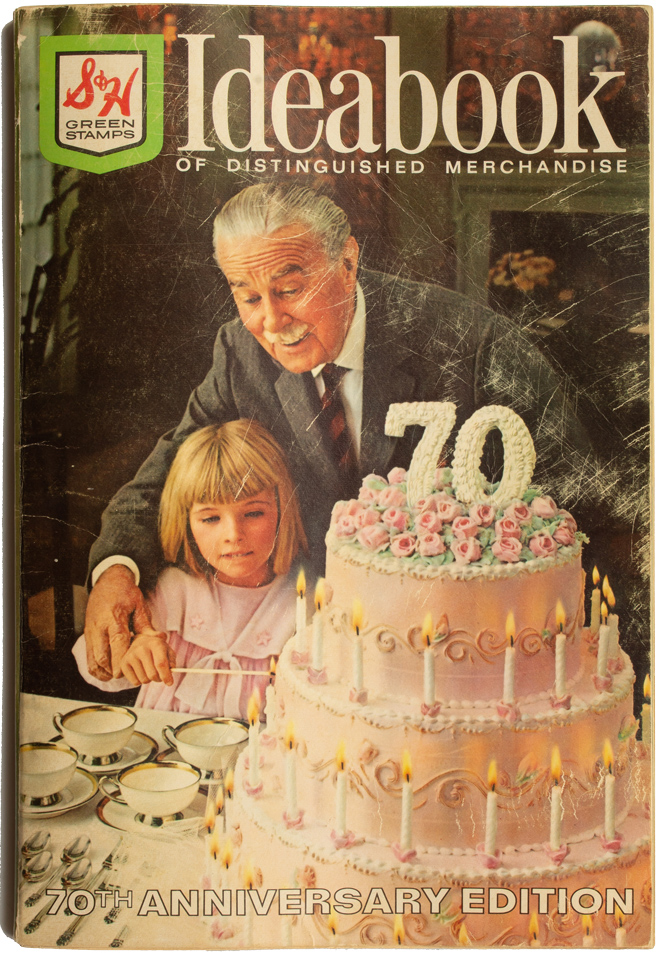
The (pre-computer and internet) logistics for claiming a S&H Green Stamps reward were extensive; the member needed to fill books with stamps, choose the reward products, fill out a separate order form for each reward, then send the books and order forms (plus applicable sales taxes) via first class mail to their nearest distribution centre. Alternatively, the member could visit one of hundreds of retail outlets and spend the stamp books directly. The overheads of running such a massive operation would have been enormous.
The demand for stamps went through several phases during the 1900s. According to the US National Commission on Food Marketing,[23] by 1914 around 7 per cent of retail trade involved the awarding of stamps. This reduced to 2 per cent during World War 1. The Great Atlantic & Pacific Tea Co dropped S&H Green Stamps altogether during the war, which would have been a major blow to Sperry & Hutchison, as they lost the largest grocery chain in the country. Stamps earning stabilised at 2 to 3 per cent of retail trade during the 1920s but fell substantially during the Great Depression and all the way through World War 2.
Post-war, interest in stamps increased substantially. Thirty million US dollars’ worth of industry stamps sales were recorded in 1950 in the US, and this grew to US$754 million by 1963, accounting for 16 per cent of total retail trade, and a whopping 47 per cent of grocery trade. Research from the period by Benson and Benson Consumer Studies indicated 83 per cent of all families in the US were saving stamps.[24]
In the US alone there were an estimated 250 to 500 stamp companies operating at the peak of the ‘the golden age of stamps’.[25]
Stamps also expanded globally. In the UK, Green Shield and Co-Op Stamps were two popular programs of many, while in Australia, Green Coupon, Aussie Blue and Group Tokens operated in a competitive market. Other countries also adopted stamps en-masse, including Sweden, Germany, Poland, Switzerland, Canada, Austria, Germany and many more.
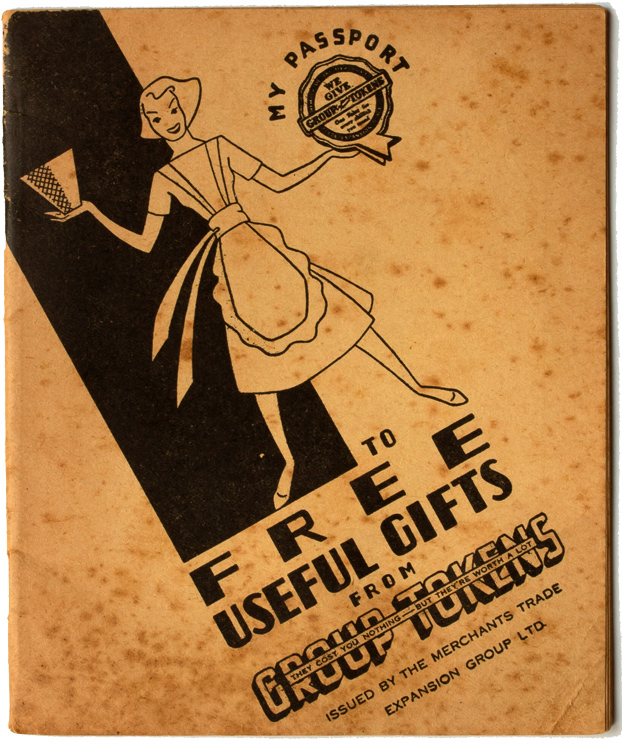
Of notable interest is two case studies documented by the US National Commission on Food Marketing which measured whether stamps were successful in helping companies grow revenue.[26] The first related to a business which introduced stamps in a market which did not previously have stamps. The second related to a business which introduced stamps in a market where stamps were already used extensively by their main competitors. While the circumstances for the two studies were different, in both instances within two years gross margins increased by an amount exceeding the cost of the stamps, demonstrating the programs were a success.
Betty Crocker Coupons (1921)
Stamps were not the only major loyalty currency during this period. In 1921, The Washburn Crosby Company, a flour-milling company and largest predecessor of General Mills, Inc., invented fictional character Betty Crocker to personalise responses to consumer inquiries generated by a promotion for Gold Medal flour.[27] In 1931, the company included a coupon for a silver-plated spoon within Wheaties cereal boxes and bags of Gold Medal flour.[28] The promotion was so successful, the company followed up the next year with a coupon program which allowed customers to access a complete set of flatware. Starting from 1937, the ‘Betty Crocker Coupons’ were printed on the outside of the box, enabling customers to see how many they could earn with the purchase. In 1962, the Betty Crocker Coupon Catalog was released, an annual publication ‘Featuring over 400 items tested and checked for quality in the Betty Crocker kitchens of the world.’[29]
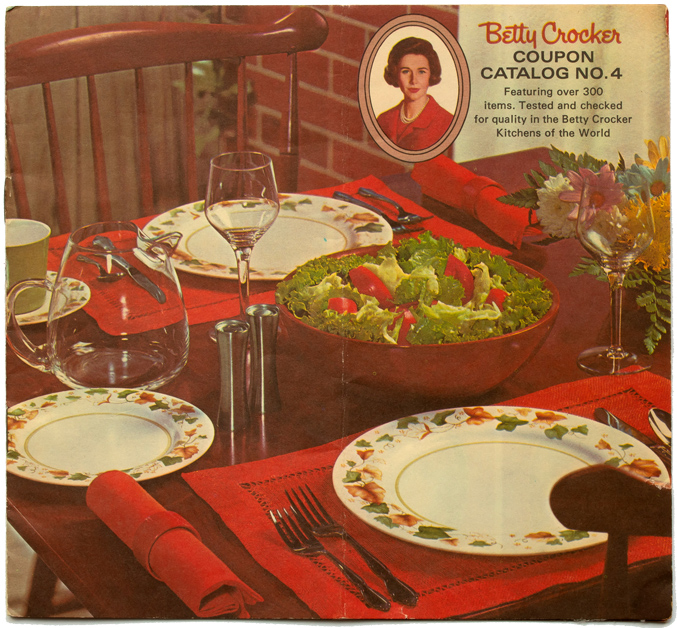
A study of the history of Betty Crocker Coupons introduces the concept of emotional engagement generated by a loyalty program. Mark Bergen, marketing department chair at the University of Minnesota’s Carlson School of Management, said the Betty Crocker program was remarkable for two characteristics – its longevity and the depth of emotion it inspired among its devotees. It became more than a coupon redemption program, Bergen said, by working its way into the fabric of family life.[30]
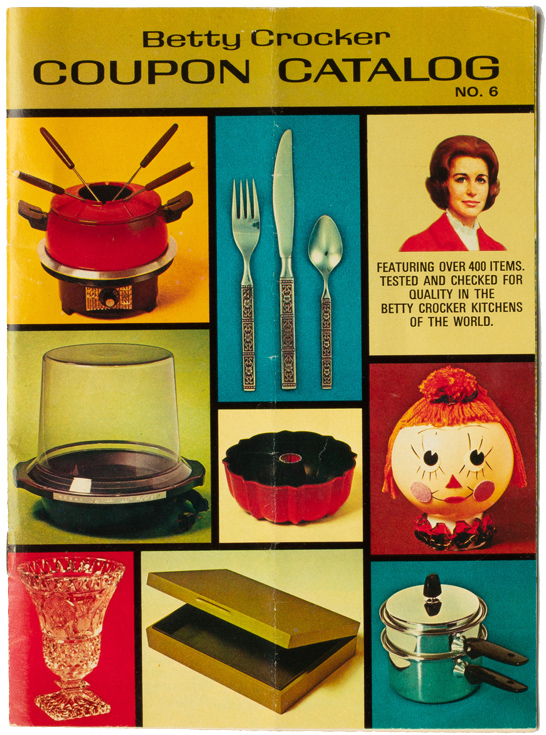
___
The mid 1960s marked the beginning of the slow demise of stamps. Some supermarkets dropped stamps and found success by focusing their brand positioning on lowest prices to differentiate against competitors. This approach soon spread to other retail and discount stores.
In the 1970s, a series of recessions and the world oil shock created hardship for most stamp coalition operators, as retail partners sought any way to cut costs. Large-scale rejection of stamps by retailers led to a sudden drop in revenue, and combined with the large cost overheads, ongoing operations became incredibly challenging.
To understand the size of such savings made by supermarkets, in 1977 Tesco in the UK ditched Green Shield Stamps, saving the company an estimated £20m a year[31] (the equivalent of £120m today), which they reinvested in cutting costs.
Miles & Points (1980s)
In 1981, American Airlines launched the world’s first currency based frequent flyer program using a new currency (‘miles’) which corresponded to how many miles a member had flown.[32] Members could earn miles at a set value for free flights allowing them to easily identify what they could redeem their miles for. Brought on by increasing competition with the deregulation of the US airline industry in 1978, the American Airlines AAdvantage program was soon followed by similar schemes from United Airlines, TWA and Delta Airlines.[33]
In 1982, American Airlines upped the ante by introducing a Gold tier to recognise their most loyal members. The same year they launched earn partnerships with Hertz, Holland American Line and British Airways, forming the basis of the first modern coalition program.

Over the next five years, a boom in miles and points-based loyalty programs ensued, including new programs from Holiday Inn (the first hotel program), Japan Airlines, Marriott, Alaska Airlines, Aeroplan, Korean Air, Pan Am, Diners Club, Northwest Airlines, Continental Airlines (which, in conjunction with the Bank of Main Midland, launched the world’s first co-branded credit card program), Hilton, Hyatt, National Car Rental, Holiday Inn, Southwest Airlines (which introduced ‘points’ rather than ‘miles’ for the first time) and Qantas.
As happened with American Airlines, soon after the launch of these large programs, hotel and car rental companies began partnering with the airlines, and started offering miles and points as a strategy to grow their share of the lucrative business traveller and high-value leisure traveller markets.
With the rapid expansion of the frequent flyer and hotel coalition models and their new currencies, banks and retailers soon replicated their approach. Points and miles loyalty programs quickly became the dominant loyalty program currency globally, ending the ninety-year reign of stamps.
General Mills tried to revitalise the Betty Crocker program by changing coupons to points in 1989.[34] The program was eventually retired in 2006, with Bergen of the Carlson School arguing the decline in engagement was due to shopping pattern changes.[35] Households had given up the habit of saving for a future purchase and started buying on credit, while the idea of cutting out box top coupons and sending them in the mail became old-fashioned in the age of plastic membership cards and ever-evolving reward ranges.
Sperry & Hutchinson also tried to reinvent themselves in 1989, launching a plastic member card which could be swiped at cash registers to earn points. This evolved into S&H Greenpoints in 1999, an attempt to weave the 104-year-old company into the dotcom boom. By 2000, they had attracted 88 participating retailers, including OfficeMax.com, Borders.com and LandsEnd.com.[36] In 2006, the company was purchased by Pay By Touch for over US$100 million in cash and stock.[37] Their demise should be listed alongside such companies as Kodak, such was the scale of their operation and influence on retail marketing globally, not to mention their penetration of households.
Increasing competition, combined with the birth of the digital age, led to a loyalty program innovation boom from the 1990s onwards. Coalition programs launched online reward stores with thousands of consumer products and gift cards, expanded into insurance products, branded credit cards, financial services, food and wine clubs, massive partner networks and digital marketing agencies. In addition, they developed specialised capabilities in data capture, usage and monetisation, all of which will be explored in later chapters.
Cryptocurrencies and Tokenised Assets (Today)
From 2017, several start-ups launched new coalition programs rewarding members with tradeable ‘cryptocurrencies’, such as Bitcoin, Ethereum and branded crypto tokens. The novel variation with cryptocurrencies as a loyalty currency was that the value could increase or decrease based on speculative trading behaviour. The approach taken by start-ups was to establish a coalition program to drive demand for the cryptocurrency, which would subsequently increase in value, benefiting existing members. Most programs failed to deliver the sustained demand necessary to protect the market price of their cryptocurrencies, which instead decreased in value aligning with market sentiment. Programs offering Bitcoin have achieved market traction and continue to build global engagement.
Other programs have evolved to reward members with ‘tokenised assets’. Examples include BrickX (reward members with real estate), Almond (reward members with carbon offsets/tree planting), Bits of Stock (reward members with partner company shares). Shares and real estate allow the member to earn dividends on their tokens (a hark back to B.T. Babbitts). Carbon credits can be offset against tree plantings or even traded. Ostensibly any physical asset can be tokenised, opening up an exciting new future in the evolution of loyalty currencies.
___
From a loyalty program design perspective, the most fascinating aspect of the historical review is that the core design of a program has remained consistent throughout. The currencies have changed constantly; trade marks, checks, tickets, coupons, certificates, stamps, miles, points, cryptocurrencies, tokenised assets and many other variations have all been used. But the program design has not changed. All the companies included in the historical research followed the exact same approach; providing a tokenised currency to a customer when they spent, and allowing the customer to redeem the accumulated currency for a desirable reward.
It is a consumer-engagement model which has stood the test of time.
*All images of loyalty history memorabilia are from the author, Philip Shelper (unless stated).
Do loyalty programs work?
Do loyalty programs work? Review our case studies of brands that and generating incredible results from their loyalty programs.
Bibliography
[1] Kemp, B. J., 2005, ‘Ancient Egypt: Anatomy of a Civilization, 2nd Edition’.
[2] Nagle, J., 1971, ’Trading Stamps: A Long History’, New York Times, https://www.nytimes.com/1971/12/26/archives/trading-stamps-a-long-history-premiums-said-to-date-back-in-us-to.html, accessed 22 April 2020.
[3] Fuld, G. & Fuld, M., 1975, ‘U.S. Civil War Store Cards’, Quarterman Publishing, Inc.
[4] Mudd, D., 2015, ‘Hard Times Tokens’, American Numismatic Association, https://www.money.org/ana-blog/TalesHardTimesTokens, accessed 22 April 2020.
[5] Barnard, B. W., 1917, ‘The Use of Private Tokens for Money in the United States’, The Quarterly Journal of Economics, Vol 31, No. 4, pp600-634.
[6] Ingam, J.N., 1983, ‘Biographical dictionary of American business leaders’, Greenwood Press.
[7] National Commission on Food Marketing, 1966, ‘Organization and competition in food retailing’, Technical study No.7, p41
[8] B.T. Babbitt, Incorporated, 1905, ‘Mailing List of Premiums’.
[9] B.T. Babbitt, Incorporated, 1912, ‘B.T. Babbitt’s Profit Sharing List’.
[10] Levinson, M., 2012, ‘Don’t Grieve for the Great A&P’, Harvard Business Review.
[11] The Great Atlantic And Pacific Tea Co, 1890, ‘1890 Great Atlantic & Pacific Tea Co. Coupon Premium – Handstamp of Big Bleecker’.
[12] Levison, M., 2011, ‘The Great A&P and the Struggle for Small Business in America,’ Hill & Wang, 2011.
[13] The Great Atlantic & Pacific Tea Co, ‘Great Atlantic & Pacific Tea Co Catalogue,’ 1908.
[14] Levison, M., ‘The Great A&P and the Struggle for Small Business in America,’ Hill & Wang.
[15] Grand Union Tea Company, 1903, ‘Catalogue Of Premiums’.
[16] Nagle, J., 1971, ’Trading Stamps: A Long History’, New York Times, https://www.nytimes.com/1971/12/26/archives/trading-stamps-a-long-history-premiums-said-to-date-back-in-us-to.html, accessed 22 April 2020.
[17] Hunsicker & Warmkessel, 1890, ‘People’s Trading Coupon’, Allentown, PA.
[18] United Cigar Stores, IMASCO, http://www.imascoltd.com/united-cigar-stores/, Accessed 7 April 2020.
[19] United Cigar Stores Company of America, 1924, ‘Premium Catalog’.
[20] Dahlsad, D., 2013, ‘Inherited Values’, http://www.inherited-values.com/2013/09/meet-me-down-by-schusters-vintage-department-store-memories-collectibles/, accessed 4May 2020.
[21] Lonto, J. R., 2013, ‘The Trading Stamp Story,’ StudioZ-7 Publishing, http://www.studioz7.com/stamps.html, accessed 4 May 2020.
[22] Sperry & Hutchinson Company, 1966, ‘Ideabook Of Distinguished Merchandise 70th Anniversary Edition’, S&H Green Stamps.
[23] National Commission on Food Marketing, 1966, ‘Organization and competition in food retailing’, Technical study No.7.
[24] National Commission on Food Marketing, 1966, ‘Organization and competition in food retailing’, Technical study No.7.
[25] Ibid.
[26] Ibid.
[27] Betty Crocker, 2017, ‘The story of Betty Crocker’, https://www.bettycrocker.com/menus-holidays-parties/mhplibrary/parties-and-get-togethers/vintage-betty/the-story-of-betty-crocker, accessed 2 May 2020.
[28] McKinney, M., 2006, ‘Betty Crocker closing the book on its catalog sales’, Minneapolis Star Tribune, https://www.chron.com/life/article/Betty-Crocker-closing-the-book-on-its-catalog-1506961.php, accessed 2 May 2020.
[29] Betty Crocker, 1968, ‘Betty Crocker Coupon Catalog’, No 6.
[30] Wilcoxen, W., 2006, ‘Betty Crocker retires her catalog’, MPR News, https://www.mprnews.org/story/2006/11/28/bettycrocker, accessed 2 May 2020.
[31] Mason, T., 2019, ‘Omnichannel Retail,’ Kogan Page
[32] Everett, M. R., 1995, ‘Diffusion of Innovations’, The Free Press, 4th Edition.
[33] De Boer, E. R., 2018, ‘Strategy in Airline Loyalty: Frequent Flyer Programs,’ Palgrave Macmillan.
[34] McKinney, M., 2006, ‘Betty Crocker closing the book on its catalog sales,’ Minneapolis Star Tribune, https://www.chron.com/life/article/Betty-Crocker-closing-the-book-on-its-catalog-1506961.php, accessed 2 May 2020.
[35] Wilcoxen, W., 2006, ‘Betty Crocker retires her catalog’, MPR News, https://www.mprnews.org/story/2006/11/28/bettycrocker, accessed 2 May 2020.
[36] Slatalla, M., 2000, ‘Clicks, Not Licks, as Green Stamps Go Digital’, New York Times, https://www.nytimes.com/2000/03/09/technology/online-shopper-clicks-not-licks-as-green-stamps-go-digital.html, accessed 1 May 2020.
[37] The Wise Marketer, 2006, ‘Pay By Touch snaps up S&H Solutions & Greenpoints’, https://thewisemarketer.com/headlines/pay-by-touch-snaps-up-sh-solutions-greenpoints-2/, accessed 2 June 2020.

